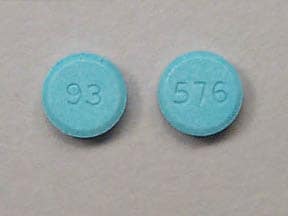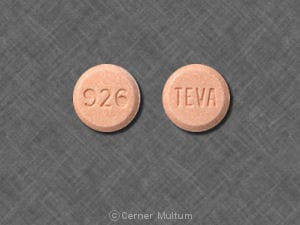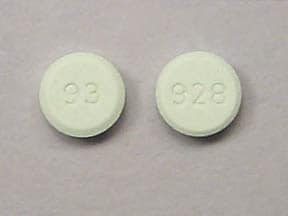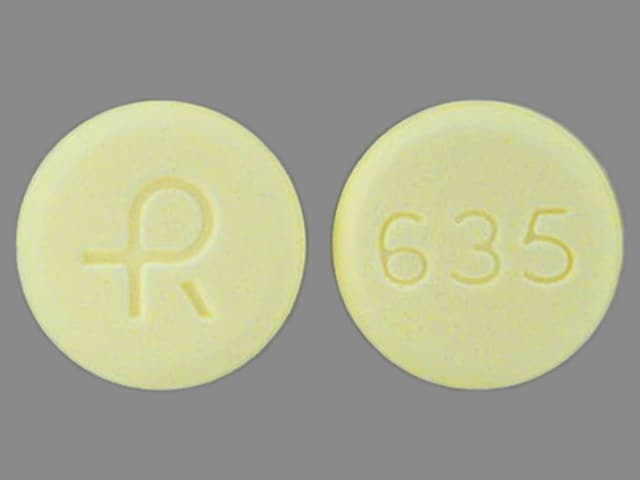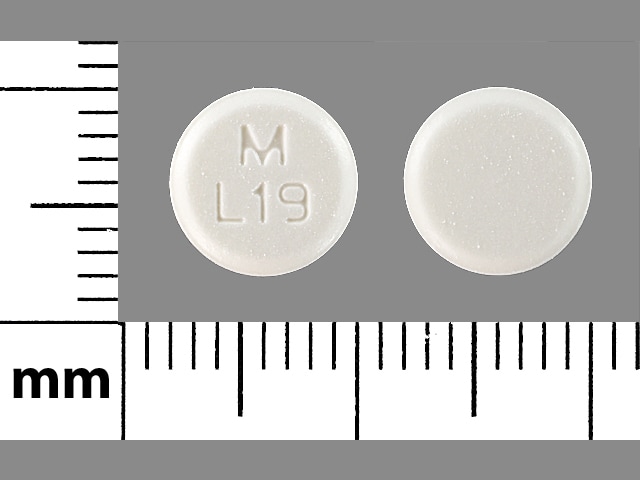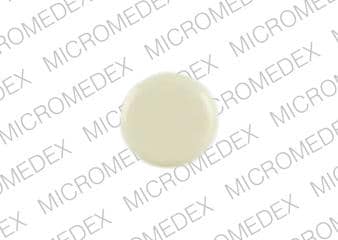Dosage Forms
Excipient information presented when available (limited, particularly for generics); consult specific product labeling. [DSC] = Discontinued product
Tablet, Oral:
Mevacor: 40 mg [DSC]
Generic: 10 mg, 20 mg, 40 mg
Tablet Extended Release 24 Hour, Oral:
Altoprev: 20 mg, 40 mg, 60 mg [contains corn starch, fd&c yellow #6 (sunset yellow)]
Pharmacology
Mechanism of Action
Lovastatin acts by competitively inhibiting 3-hydroxyl-3-methylglutaryl-coenzyme A (HMG-CoA) reductase, the enzyme that catalyzes the rate-limiting step in cholesterol biosynthesis. In addition to the ability of HMG-CoA reductase inhibitors to decrease levels of high-sensitivity C-reactive protein (hsCRP), they also possess pleiotropic properties including improved endothelial function, reduced inflammation at the site of the coronary plaque, inhibition of platelet aggregation, and anticoagulant effects (de Denus 2002; Ray 2005).
Pharmacokinetics/Pharmacodynamics
Absorption
30% absorbed but less than 5% reaches the systemic circulation due to an extensive first-pass effect; increased with extended release tablets when taken in the fasting state
Metabolism
Hepatic; extensive first-pass effect; hydrolyzed to β-hydroxyacid (active)
Excretion
Feces (~80% to 85%); urine (10%)
Onset of Action
LDL-cholesterol reductions: 3 days
Time to Peak
Serum: Immediate release: 2-4 hours; extended release: 12-14 hours
Half-Life Elimination
1.1-1.7 hours
Protein Binding
>95%
Use in Specific Populations
Special Populations: Renal Function Impairment
Plasma concentrations of total inhibitors are increased 2-fold in severe renal insufficiency (CrCl <30 mL/minute).
Special Populations: Elderly
The mean plasma level of HMG-CoA reductase inhibitory activity was increased approximately 45% in elderly patients 70 to 78 years of age compared with patients 18 to 30 years of age.
Use: Labeled Indications
Adjunct to dietary therapy to decrease elevated serum total and LDL-cholesterol concentrations in primary hypercholesterolemia
Primary prevention of coronary artery disease (patients without symptomatic disease with average to moderately elevated total and LDL-cholesterol and below average HDL-cholesterol); slow progression of coronary atherosclerosis in patients with coronary heart disease and reduce the risk of myocardial infarction, unstable angina, and coronary revascularization procedures.
Adjunct to dietary therapy in adolescent patients (10 to 17 years of age, females >1 year postmenarche) with heterozygous familial hypercholesterolemia having LDL >189 mg/dL, or LDL >160 mg/dL with positive family history of premature cardiovascular disease (CVD), or LDL >160 mg/dL with the presence of at least two other CVD risk factors
Use: Off Label
Cardiac risk reduction for noncardiac surgery (perioperative therapy)yes
Based on the 2014 American College of Cardiology/American Heart Association (ACC/AHA) guidelines on perioperative cardiovascular evaluation and management of patients undergoing noncardiac surgery, perioperative initiation of statins is reasonable for patients undergoing vascular surgery and may be considered in patients with clinical indications according to guideline-directed medical therapy who are undergoing elevated risk procedures. In patients undergoing non-cardiac surgery who are currently receiving a statin, the statin should be continued.
Noncardioembolic stroke/TIA (secondary prevention)yes
Based on the American Heart Association/American Stroke Association (AHA/ASA) guidelines for the prevention of stroke in patients with stroke and transient ischemic attack, statin therapy with intensive lipid-lowering effects is recommended to reduce the risk of recurrent stroke and future cardiovascular events in patients with ischemic stroke or TIA presumed to be of atherosclerotic origin who have an LDL-C concentration ≥100 mg/dL (with or without evidence for other clinical atherosclerotic cardiovascular disease [ASCVD]) or who have an LDL-C concentration <100 mg/dL (without evidence for other clinical ASCVD).
Contraindications
Hypersensitivity to lovastatin or any component of the formulation; active liver disease; unexplained persistent elevations of serum transaminases; concomitant use of strong CYP3A4 inhibitors (eg, clarithromycin, erythromycin, itraconazole, ketoconazole, nefazodone, posaconazole, voriconazole, protease inhibitors [including boceprevir and telaprevir], telithromycin, cobicistat-containing products); pregnancy; breastfeeding
Canadian labeling: Additional contraindications (not in US labeling): Concomitant use of cyclosporine
Dosage and Administration
Dosing: Adult
Dyslipidemia and primary prevention of CAD: Oral:
Immediate release: Initial: 20 mg once daily with evening meal, then adjust at 4-week intervals; maximum dose: 80 mg daily
Extended release: Initial: 20, 40, or 60 mg once daily at bedtime, then adjust at 4-week intervals; maximum dose: 60 mg daily
Note: Doses should be individualized according to the baseline LDL-cholesterol levels, the recommended goal of therapy, and patient response. For patients requiring smaller reductions in cholesterol, the use of the extended release tablet is not recommended; consider use of immediate release formulation.
Prevention of cardiovascular disease/reduce the risk of atherosclerotic cardiovascular disease: Oral:
ACC/AHA Blood Cholesterol Guideline recommendations (ACC/AHA [Grundy 2018]; ACC/AHA [Stone 2013]):
Note: When choosing to initiate therapy and selecting dose-intensity, consider atherosclerotic cardiovascular disease (ASCVD) risk, risk-enhancing factors, possibility for side effects, and drug interactions.
Primary prevention:
LDL-C ≥190 mg/dL and age 20 to 75 years: High-intensity therapy necessary; use alternate statin therapy (eg, atorvastatin or rosuvastatin)
Diabetes, age 40 to 75 years and an estimated 10-year ASCVD risk <7.5%: Moderate-intensity therapy: Immediate release: 40 mg once daily
Diabetes, age 40 to 75 years and an estimated 10-year ASCVD risk ≥7.5%: High-intensity therapy necessary; use alternate statin therapy (eg, atorvastatin or rosuvastatin)
LDL-C 70 to 189 mg/dL, age 40 to 75 years and an estimated 10-year ASCVD risk ≥7.5%: Moderate to high-intensity therapy: Immediate release: 40 mg once daily or consider using high-intensity statin therapy (eg, atorvastatin or rosuvastatin)
Secondary prevention:
Patient has clinical ASCVD (eg, coronary heart disease, stroke/TIA, or peripheral arterial disease presumed to be of atherosclerotic origin) or is post-CABG (AHA [Kulik 2015]) and:
Age ≤75 years: High-intensity therapy necessary; use alternate statin therapy (eg, atorvastatin or rosuvastatin)
Age >75 years: Moderate- to high-intensity therapy: Immediate release: 40 mg once daily or consider using high-intensity statin therapy (eg, atorvastatin or rosuvastatin); if moderate-intensity therapy is started and tolerated, increase to a high-intensity statin therapy within 3 months (Rosenson 2019).
US Preventive Services Task Force Recommendations (USPSTF 2016): Age 40 to 75 years, no history of CVD, with ≥1 CVD risk factor (dyslipidemia, diabetes, hypertension, or smoking), and calculated 10-year CVD event risk of ≥10%:
Primary prevention:
Low-intensity therapy: 20 mg once daily
Moderate-intensity therapy: 40 mg once daily
Note: These recommendations do not pertain to patients with very high CVD risk factors (eg, LDL >190 mg/dL, familial hypercholesterolemia) (were excluded from primary prevention trials); use clinical judgment in the treatment of these patients. In patients with a calculated 10-year CVD event risk of 7.5% to 10%, may consider use of a statin based on patient characteristics.
Dosage adjustment for lovastatin with concomitant medications:
Amiodarone: Maximum recommended lovastatin dose (extended release and immediate release): 40 mg daily
Danazol, diltiazem, dronedarone, or verapamil: Initial lovastatin (immediate release) dose: 10 mg daily; Maximum recommended lovastatin (extended release and immediate release) dose: 20 mg daily
Lomitapide: Consider lovastatin dose reduction (per lomitapide manufacturer).
Ranolazine: Consider lovastatin dose reduction.
Dosing: Geriatric
Immediate release: Refer to adult dosing; Extended release: Initial: 20 mg once daily at bedtime
Dosing: Pediatric
Dyslipidemia; prevention coronary artery disease (CAD): Adolescents ≥18 years: Oral: Immediate release: Initial: 20 mg once daily with evening meal, then adjust at 4-week intervals; maximum daily dose: 80 mg/day. Note: Doses should be individualized according to the baseline LDL-cholesterol levels, the recommended goal of therapy, and patient response.
Heterozygous familial hypercholesterolemia: Note: Begin treatment if after adequate (eg, 6 month) trial of lifestyle/diet modifications the following are present: LDL-C ≥190 mg/dL or LDL-C remains ≥160 mg/dL with either a positive family history of premature cardiovascular disease or at least 1 high-level or 2 moderate-level risk factors. Females must be ≥1 year postmenarche (NHLBI 2011).
Children ≥10 years and Adolescents ≤17 years: Oral: Immediate release: Initial: 10 mg once daily with evening meal (Clauss 2005; Lambert 1996; NHLBI 2011; Stein 1999); if target LDL-C levels are not reached within 3 months, increase dose in 10 mg increments every 3 months until target LDL-C achieved; usual effective range: 10 to 40 mg once daily; maximum daily dose: 80 mg/day (Clauss 2005; Lambert 1996; NHLBI 2011; Stein 1999). Lower initial doses or maximum daily doses may be necessary for some concomitant medications (eg, amiodarone, verapamil, danazol, diltiazem). Note: Children 8 to <10 years of age are not typically treated unless severe primary hyperlipidemias and high-risk condition associated with high morbidity; data for the use of lovastatin in these younger patients is lacking (NHLBI 2011).
Dosing adjustment for lovastatin with concomitant medications: There are no recommendations in the manufacturer's labeling for patients <18 years. In adolescents ≥18 years, the following have been suggested:
Amiodarone: Maximum recommended lovastatin daily dose: 40 mg/day (immediate release)
Danazol, diltiazem, dronedarone, or verapamil: Reduced initial lovastatin (immediate release) dose: 10 mg once daily; maximum recommended daily lovastatin dose: 20 mg/day
Lomitapide, ranolazine: Consider lovastatin dose reduction.
Dosing adjustment for toxicity: Muscle symptoms (potential myopathy): Children ≥10 years and Adolescents: Discontinue use until symptoms can be evaluated; check creatine phosphokinase (CPK) level; based on experience in adult patients, also evaluate patient for conditions that may increase the risk for muscle symptoms (eg, hypothyroidism; reduced renal or hepatic function; rheumatologic disorders such as polymyalgia rheumatica, steroid myopathy, vitamin D deficiency, or primary muscle diseases). Upon resolution (symptoms and any associated CPK abnormalities), resume the original or consider a lower dose of lovastatin and retitrate. If muscle symptoms recur, discontinue lovastatin use. After muscle symptom resolution, may then reinitiate a different statin at an initial low dose; gradually increase if tolerated. Based on experience in adult patients, if muscle symptoms or elevated CPK persists for 2 months in the absence of continued statin use, consider other causes of muscle symptoms. If determined to be due to another condition aside from statin use, may resume statin therapy at the original dose (NHLBI 2011; Stone 2013).
Dosing: Adjustment for Toxicity
Severe muscle symptoms or fatigue: Promptly discontinue use; evaluate CPK, creatinine, and urinalysis for myoglobinuria (ACC/AHA [Stone 2013]).
Mild to moderate muscle symptoms: Discontinue use until symptoms can be evaluated; evaluate patient for conditions that may increase the risk for muscle symptoms (eg, hypothyroidism, reduced renal or hepatic function, rheumatologic disorders such as polymyalgia rheumatica, steroid myopathy, vitamin D deficiency, or primary muscle diseases). Upon resolution, resume the original or lower dose of lovastatin. If muscle symptoms recur, discontinue lovastatin use. After muscle symptom resolution, may then use a low dose of a different statin; gradually increase if tolerated. In the absence of continued statin use, if muscle symptoms or elevated CPK continues after 2 months, consider other causes of muscle symptoms. If determined to be due to another condition aside from statin use, may resume statin therapy at the original dose (ACC/AHA [Stone 2013]).
Administration
Administer immediate release tablet with the evening meal. Administer extended release tablet at bedtime; do not crush or chew.
Dietary Considerations
Before initiation of therapy, patients should be placed on a standard cholesterol-lowering diet for 6 weeks and the diet should be continued during drug therapy. Avoid intake of grapefruit juice; may increase toxicity. Immediate release tablet should be taken with the evening meal.
Red yeast rice contains variable amounts of several compounds that are structurally similar to HMG-CoA reductase inhibitors, primarily monacolin K (or mevinolin) which is structurally identical to lovastatin; concurrent use of red yeast rice with HMG-CoA reductase inhibitors may increase the incidence of adverse and toxic effects (Lapi 2008; Smith 2003).
Storage
Tablet, immediate release: Store at 20°C to 25°C (68°F to 77°F). Protect from light
Tablet, extended release: Store at 20°C to 25°C (68°F to 77°F); excursions permitted between 15°C to 30°C (59°F to 86°F). Avoid excessive heat and humidity.
Lovastatin Images
Drug Interactions
Acipimox: May enhance the myopathic (rhabdomyolysis) effect of HMG-CoA Reductase Inhibitors (Statins). Monitor therapy
Amiodarone: May increase the serum concentration of Lovastatin. Management: Consider using a non-interacting statin (pravastatin, pitavastatin) in patients on amiodarone. If combined, limit the adult lovastatin dose to 40 mg daily and monitor for lovastatin toxicities (eg, myalgia, liver function test elevations, rhabdomyolysis). Consider therapy modification
AmLODIPine: May increase the serum concentration of Lovastatin. Monitor therapy
Aprepitant: May increase the serum concentration of CYP3A4 Substrates (High risk with Inhibitors). Monitor therapy
Asunaprevir: May increase the serum concentration of HMG-CoA Reductase Inhibitors (Statins). Monitor therapy
Azithromycin (Systemic): May enhance the myopathic (rhabdomyolysis) effect of Lovastatin. Monitor therapy
Bezafibrate: May enhance the myopathic (rhabdomyolysis) effect of HMG-CoA Reductase Inhibitors (Statins). Bezafibrate may increase the serum concentration of HMG-CoA Reductase Inhibitors (Statins). More specifically, bezafibrate may increase the serum concentration of fluvastatin Management: Monitor patients closely for myopathy with concomitant use of bezafibrate and HMG-CoA reductase inhibitors. Concomitant use is contraindicated in patients predisposed to myopathy and alternative therapy should be considered. Consider therapy modification
Bosentan: May decrease the serum concentration of CYP3A4 Substrates (High risk with Inducers). Monitor therapy
Ciprofibrate: May enhance the adverse/toxic effect of HMG-CoA Reductase Inhibitors (Statins). Management: Avoid the use of HMG-CoA reductase inhibitors and ciprofibrate if possible. If concomitant therapy is considered, benefits should be carefully weighed against the risks, and patients should be monitored closely for signs/symptoms of muscle toxicity. Consider therapy modification
Clarithromycin: May increase the serum concentration of Lovastatin. Avoid combination
Clofazimine: May increase the serum concentration of CYP3A4 Substrates (High risk with Inhibitors). Monitor therapy
Colchicine: May enhance the myopathic (rhabdomyolysis) effect of HMG-CoA Reductase Inhibitors (Statins). Colchicine may increase the serum concentration of HMG-CoA Reductase Inhibitors (Statins). Consider therapy modification
Conivaptan: May increase the serum concentration of CYP3A4 Substrates (High risk with Inhibitors). Avoid combination
CycloSPORINE (Systemic): May increase the serum concentration of Lovastatin. Avoid combination
CYP3A4 Inducers (Moderate): May decrease the serum concentration of CYP3A4 Substrates (High risk with Inducers). Monitor therapy
CYP3A4 Inducers (Strong): May increase the metabolism of CYP3A4 Substrates (High risk with Inducers). Management: Consider an alternative for one of the interacting drugs. Some combinations may be specifically contraindicated. Consult appropriate manufacturer labeling. Consider therapy modification
CYP3A4 Inhibitors (Moderate): May decrease the metabolism of CYP3A4 Substrates (High risk with Inhibitors). Monitor therapy
CYP3A4 Inhibitors (Strong): May increase the serum concentration of Lovastatin. Avoid combination
Cyproterone: May increase the serum concentration of HMG-CoA Reductase Inhibitors (Statins). Management: Avoid use of statins metabolized by CYP3A4 (eg, simvastatin) and consider avoiding fluvastatin as well in patients receiving high dose cyproterone (300 mg/day). Consider use of pravastatin, rosuvastatin, or pitavastatin if statin therapy is needed. Consider therapy modification
Dabigatran Etexilate: Lovastatin may enhance the anticoagulant effect of Dabigatran Etexilate. Monitor therapy
Dabrafenib: May decrease the serum concentration of CYP3A4 Substrates (High risk with Inducers). Management: Seek alternatives to the CYP3A4 substrate when possible. If concomitant therapy cannot be avoided, monitor clinical effects of the substrate closely (particularly therapeutic effects). Consider therapy modification
Daclatasvir: May increase the serum concentration of HMG-CoA Reductase Inhibitors (Statins). Monitor therapy
Danazol: May increase the serum concentration of HMG-CoA Reductase Inhibitors (Statins). Management: Concurrent use of simvastatin with danazol is contraindicated. Do not exceed 20 mg per day of lovastatin if combined with danazol. Fluvastatin, pravastatin, and rosuvastatin may pose lower risk. Consider therapy modification
DAPTOmycin: HMG-CoA Reductase Inhibitors (Statins) may enhance the adverse/toxic effect of DAPTOmycin. Specifically, the risk of skeletal muscle toxicity may be increased. Management: Consider temporarily stopping HMG-CoA reductase inhibitor therapy prior to daptomycin. If used together, regular (i.e., at least weekly) monitoring of CPK concentrations is recommended. Consider therapy modification
Deferasirox: May decrease the serum concentration of CYP3A4 Substrates (High risk with Inducers). Monitor therapy
DilTIAZem: Lovastatin may increase the serum concentration of DilTIAZem. DilTIAZem may increase the serum concentration of Lovastatin. Management: Initiate lovastatin at a maximum adult dose of 10 mg/day, and do not exceed 20 mg/day, in patients receiving diltiazem. Monitor closely for signs of HMG-CoA reductase inhibitor toxicity (e.g., myositis, rhabdomyolysis). Consider therapy modification
Dronedarone: May increase the serum concentration of Lovastatin. Management: Limit lovastatin to a maximum of 20 mg/day (in adults). Increase monitoring for signs of lovastatin toxicity (e.g., myopathy, rhabdomyolysis). Consider therapy modification
Duvelisib: May increase the serum concentration of CYP3A4 Substrates (High risk with Inhibitors). Monitor therapy
Efavirenz: May decrease the serum concentration of Lovastatin. Monitor therapy
Elbasvir: May increase the serum concentration of Lovastatin. Monitor therapy
Enzalutamide: May decrease the serum concentration of CYP3A4 Substrates (High risk with Inducers). Management: Concurrent use of enzalutamide with CYP3A4 substrates that have a narrow therapeutic index should be avoided. Use of enzalutamide and any other CYP3A4 substrate should be performed with caution and close monitoring. Consider therapy modification
Erdafitinib: May decrease the serum concentration of CYP3A4 Substrates (High risk with Inducers). Monitor therapy
Erdafitinib: May increase the serum concentration of CYP3A4 Substrates (High risk with Inhibitors). Monitor therapy
Erdafitinib: May increase the serum concentration of P-glycoprotein/ABCB1 Substrates. Monitor therapy
Erythromycin (Systemic): May increase the serum concentration of Lovastatin. Avoid combination
Etravirine: May decrease the serum concentration of HMG-CoA Reductase Inhibitors (Statins). This applies to atorvastatin, lovastatin and simvastatin. Monitor therapy
Fenofibrate and Derivatives: May enhance the adverse/toxic effect of HMG-CoA Reductase Inhibitors (Statins). Monitor therapy
Fluconazole: May increase the serum concentration of Lovastatin. Monitor therapy
Fosaprepitant: May increase the serum concentration of CYP3A4 Substrates (High risk with Inhibitors). Monitor therapy
Fosnetupitant: May increase the serum concentration of CYP3A4 Substrates (High risk with Inhibitors). Monitor therapy
Fosphenytoin: May decrease the serum concentration of HMG-CoA Reductase Inhibitors (Statins). Consider therapy modification
Fusidic Acid (Systemic): May enhance the adverse/toxic effect of HMG-CoA Reductase Inhibitors (Statins). Specifically, the risk for muscle toxicities, including rhabdomyolysis may be significantly increased. Management: Avoid concurrent use whenever possible. Use is listed as contraindicated in product characteristic summaries in several countries, although UK labeling suggests that use could be considered under exceptional circumstances and with close supervision. Avoid combination
Fusidic Acid (Systemic): May increase the serum concentration of CYP3A4 Substrates (High risk with Inhibitors). Avoid combination
Gemfibrozil: May enhance the myopathic (rhabdomyolysis) effect of Lovastatin. Gemfibrozil may increase the serum concentration of Lovastatin. More specifically, gemfibrozil may increase the serum concentrations of lovastatin acid (active form of parent drug). Avoid combination
Glecaprevir and Pibrentasvir: May increase the serum concentration of Lovastatin. Avoid combination
Grapefruit Juice: May increase the serum concentration of HMG-CoA Reductase Inhibitors (Statins). Management: Avoid concurrent use of GFJ with lovastatin or simvastatin. Avoid high quantities of GFJ with atorvastatin. Consider using a lower statin dose or a statin that is less likely to interact when possible. Consider therapy modification
Grazoprevir: May increase the serum concentration of Lovastatin. Monitor therapy
Idelalisib: May increase the serum concentration of CYP3A4 Substrates (High risk with Inhibitors). Avoid combination
Ivosidenib: May decrease the serum concentration of CYP3A4 Substrates (High risk with Inducers). Monitor therapy
Lanthanum: HMG-CoA Reductase Inhibitors (Statins) may decrease the serum concentration of Lanthanum. Management: Administer HMG-CoA reductase inhibitors at least two hours before or after lanthanum. Consider therapy modification
Larotrectinib: May increase the serum concentration of CYP3A4 Substrates (High risk with Inhibitors). Monitor therapy
Lasmiditan: May increase the serum concentration of P-glycoprotein/ABCB1 Substrates. Avoid combination
Letermovir: May increase the serum concentration of HMG-CoA Reductase Inhibitors (Statins). Monitor therapy
Levamlodipine: May increase the serum concentration of Lovastatin. Monitor therapy
Lomitapide: May increase the serum concentration of Lovastatin. Management: Consider reducing lovastatin doses during concomitant treatment with lomitapide, and monitor for signs and symptoms of muscle toxicity. Specific dosing recommendations are not presently available. Consider therapy modification
Lorlatinib: May decrease the serum concentration of CYP3A4 Substrates (High risk with Inducers). Management: Avoid concurrent use of lorlatinib with any CYP3A4 substrates for which a minimal decrease in serum concentrations of the CYP3A4 substrate could lead to therapeutic failure and serious clinical consequences. Consider therapy modification
MiFEPRIStone: May increase the serum concentration of Lovastatin. Management: Avoid lovastatin during and 2 weeks following mifepristone for treatment of hyperglycemia in Cushing's syndrome. The interaction magnitude could be lower with single doses used to terminate pregnancy, but neither effect has been studied clinically. Avoid combination
Mitotane: May decrease the serum concentration of CYP3A4 Substrates (High risk with Inducers). Management: Doses of CYP3A4 substrates may need to be adjusted substantially when used in patients being treated with mitotane. Consider therapy modification
Netupitant: May increase the serum concentration of CYP3A4 Substrates (High risk with Inhibitors). Monitor therapy
Niacin: May enhance the adverse/toxic effect of HMG-CoA Reductase Inhibitors (Statins). Monitor therapy
Niacinamide: May enhance the adverse/toxic effect of HMG-CoA Reductase Inhibitors (Statins). Monitor therapy
Palbociclib: May increase the serum concentration of CYP3A4 Substrates (High risk with Inhibitors). Monitor therapy
P-glycoprotein/ABCB1 Inhibitors: May increase the serum concentration of P-glycoprotein/ABCB1 Substrates. P-glycoprotein inhibitors may also enhance the distribution of p-glycoprotein substrates to specific cells/tissues/organs where p-glycoprotein is present in large amounts (e.g., brain, T-lymphocytes, testes, etc.). Monitor therapy
Phenytoin: May decrease the serum concentration of HMG-CoA Reductase Inhibitors (Statins). Consider therapy modification
Protease Inhibitors: May increase the serum concentration of Lovastatin. Avoid combination
QuiNINE: May increase the serum concentration of HMG-CoA Reductase Inhibitors (Statins). Monitor therapy
Raltegravir: May enhance the myopathic (rhabdomyolysis) effect of HMG-CoA Reductase Inhibitors (Statins). Monitor therapy
Ranolazine: May enhance the myopathic (rhabdomyolysis) effect of Lovastatin. Ranolazine may increase the serum concentration of Lovastatin. Ranolazine may also enhance the distribution of lovastatin to specific cells/tissues/organs where P-glycoprotein is present in large amounts (eg, brain, T-lymphocytes, testes, etc.). Monitor therapy
Red Yeast Rice: May enhance the adverse/toxic effect of HMG-CoA Reductase Inhibitors (Statins). Avoid combination
Repaglinide: HMG-CoA Reductase Inhibitors (Statins) may increase the serum concentration of Repaglinide. Monitor therapy
Rifamycin Derivatives: May decrease the serum concentration of HMG-CoA Reductase Inhibitors (Statins). Management: Consider use of noninteracting antilipemic agents (note: pitavastatin concentrations may increase with rifamycin treatment). Monitor for altered HMG-CoA reductase inhibitor effects. Rifabutin and fluvastatin, or possibly pravastatin, may pose lower risk. Consider therapy modification
Rupatadine: May enhance the adverse/toxic effect of HMG-CoA Reductase Inhibitors (Statins). Specifically, the risk for increased CPK and/or other muscle toxicities may be increased. Monitor therapy
Sarilumab: May decrease the serum concentration of CYP3A4 Substrates (High risk with Inducers). Monitor therapy
Siltuximab: May decrease the serum concentration of CYP3A4 Substrates (High risk with Inducers). Monitor therapy
Simeprevir: May increase the serum concentration of Lovastatin. Monitor therapy
St John's Wort: May increase the metabolism of HMG-CoA Reductase Inhibitors (Statins). Management: Consider avoiding the concomitant administration of St Johns Wort with interacting HMG-CoA reductase inhibitors in order to avoid the potential for decreased antilipemic effects. Monitor for decreased effects during concomitant therapy. Consider therapy modification
Stiripentol: May increase the serum concentration of CYP3A4 Substrates (High risk with Inhibitors). Management: Use of stiripentol with CYP3A4 substrates that are considered to have a narrow therapeutic index should be avoided due to the increased risk for adverse effects and toxicity. Any CYP3A4 substrate used with stiripentol requires closer monitoring. Consider therapy modification
Telithromycin: May increase the serum concentration of Lovastatin. Avoid combination
Ticagrelor: May increase the serum concentration of Lovastatin. Management: Avoid using doses of lovastatin greater than 40 mg/day with ticagrelor. This specific recommendation is found in the U.S. prescribing information but not in the Canadian product monograph. Consider therapy modification
Tocilizumab: May decrease the serum concentration of CYP3A4 Substrates (High risk with Inducers). Monitor therapy
Trabectedin: HMG-CoA Reductase Inhibitors (Statins) may enhance the myopathic (rhabdomyolysis) effect of Trabectedin. Monitor therapy
Verapamil: May increase the serum concentration of Lovastatin. Management: Initiate lovastatin at a maximum adult dose of 10 mg/day, and do not exceed 20 mg/day, in patients receiving verapamil. Monitor closely for signs of HMG-CoA reductase inhibitor toxicity (e.g., myositis, rhabdomyolysis). Consider therapy modification
Vitamin K Antagonists (eg, warfarin): HMG-CoA Reductase Inhibitors (Statins) may enhance the anticoagulant effect of Vitamin K Antagonists. Monitor therapy
Voxilaprevir: May increase the serum concentration of HMG-CoA Reductase Inhibitors (Statins). Management: Use the lowest statin dose possible if combined with voxilaprevir and monitor patients for increased statin effects/toxicities. Avoid concomitant use of voxilaprevir with rosuvastatin or pitavastatin, and limit pravastatin doses to 40 mg daily. Consider therapy modification
Adverse Reactions
Percentages as reported with immediate release tablets; similar adverse reactions seen with extended release tablets.
>10%: Neuromuscular & skeletal: Increased creatine phosphokinase (>2x normal) (11%)
1% to 10%:
Central nervous system: Headache (2% to 3%), dizziness (≤1%)
Dermatologic: Skin rash (≤1%)
Gastrointestinal: Flatulence (4% to 5%), constipation (2% to 4%), abdominal pain (2% to 3%), diarrhea (2% to 3%), nausea (2% to 3%), dyspepsia (1% to 2%)
Neuromuscular & skeletal: Myalgia (2% to 3%), weakness (1% to 2%), muscle cramps (≤1%)
Ophthalmic: Blurred vision (≤1%)
<1%, postmarketing, and/or case reports: Acid regurgitation, alopecia, amnesia (reversible), arthralgia, chest pain, cognitive dysfunction (reversible), cystitis (interstitial; Huang 2015), dermatomyositis, diabetes mellitus (new-onset), elevated glycosylated hemoglobin (HbA1c), eye irritation, increased blood glucose, insomnia, interstitial pulmonary disease, leg pain, memory impairment (reversible), paresthesia, pruritus, reversible confusional state, vomiting, xerostomia
Warnings/Precautions
Concerns related to adverse effects:
- Diabetes mellitus: Increases in HbA1c and fasting blood glucose have been reported with HMG-CoA reductase inhibitors; however, the benefits of statin therapy far outweigh the risk of dysglycemia.
- Endocrine effects: Reduced cholesterol synthesis as a result of therapy could theoretically lead to reduced adrenal or gonadal steroid hormone production; clinical trial data is inconsistent in regards to the effect on basal steroid hormone levels. Patients with signs/symptoms of endocrine dysfunction should be evaluated as clinically indicated; use caution with concomitant medications (eg, spironolactone, cimetidine, ketoconazole) that may reduce steroid hormone levels/activity.
- Hepatotoxicity: Persistent elevations in serum transaminases have been reported; upon dose reduction, drug interruption, or discontinuation, transaminase levels returned to or near pretreatment levels. Postmarketing reports of fatal and nonfatal hepatic failure are rare. If serious hepatotoxicity with clinical symptoms and/or hyperbilirubinemia or jaundice occurs during treatment, interrupt therapy promptly. If an alternate etiology is not identified, do not restart lovastatin. Liver enzyme tests should be obtained at baseline and as clinically indicated; routine periodic monitoring of liver enzymes is not necessary. Ethanol may enhance the potential of adverse hepatic effects; instruct patients to avoid excessive ethanol consumption.
- Myopathy/rhabdomyolysis: Rhabdomyolysis with acute renal failure secondary to myoglobinuria and/or myopathy has been reported; patients should be monitored closely. This risk is dose-related and is increased with concurrent use of strong CYP3A4 inhibitors (eg, clarithromycin, itraconazole, protease inhibitors), cyclosporine, fibric acid derivatives (eg, gemfibrozil), or niacin (doses ≥1 g/day); if concurrent use is warranted, consider lower starting and maintenance doses of lovastatin. Use caution in patients with inadequately treated hypothyroidism and those taking other drugs associated with myopathy (eg, colchicine), ≥65 years of age, and women; these patients are predisposed to myopathy. Immune-mediated necrotizing myopathy associated with HMG-CoA reductase inhibitor use has also been reported. Patients should be instructed to report unexplained muscle pain, tenderness, weakness, or brown urine, particularly if accompanied by malaise or fever. Discontinue therapy if markedly elevated CPK levels occur or myopathy is diagnosed/suspected.
Disease-related concerns:
- Hepatic impairment and/or ethanol use: Use with caution in patients who consume large amounts of ethanol or have a history of liver disease. Use is contraindicated in patients with active liver disease or unexplained transaminase elevations.
- Renal impairment: Use with caution in patients with renal impairment; risk of myopathy is increased.
Concurrent drug therapy issues:
- Drug-drug interactions: Potentially significant interactions may exist, requiring dose or frequency adjustment, additional monitoring, and/or selection of alternative therapy. Consult drug interactions database for more detailed information.
Special populations:
- Elderly: Use with caution in patients with advanced age, these patients are predisposed to myopathy.
- Surgical patients: The manufacturer recommends temporary discontinuation for elective major surgery, acute medical or surgical conditions, or in any patient experiencing an acute or serious condition predisposing to renal failure (eg, sepsis, hypotension, trauma, uncontrolled seizures). Based on current research and clinical guidelines, HMG-CoA reductase inhibitors should be continued in the perioperative period for noncardiac and cardiac surgery (ACC/AHA [Fleisher 2014]; ACC/AHA [Hillis 2011]). Perioperative discontinuation of statin therapy is associated with an increased risk of cardiac morbidity and mortality.
Other warnings/precautions:
- Hyperlipidemia: Secondary causes of hyperlipidemia should be ruled out prior to therapy.
Monitoring Parameters
ACC/AHA Blood Cholesterol Guideline recommendations (ACC/AHA [Grundy 2018]; ACC/AHA [Stone 2013]):
Lipid panel (total cholesterol, HDL, LDL, triglycerides): Lipid profile (fasting or nonfasting) before initiating treatment. Fasting lipid profile should be rechecked 4 to 12 weeks after starting therapy and every 3 to 12 months thereafter. If 2 consecutive LDL levels are <40 mg/dL, consider decreasing the dose.
Hepatic transaminase levels: Baseline measurement of hepatic transaminase levels (AST and ALT); measure AST, ALT, total bilirubin, and alkaline phosphatase if symptoms suggest hepatotoxicity (eg, unusual fatigue or weakness, loss of appetite, abdominal pain, dark-colored urine or yellowing of skin or sclera) during therapy.
CPK: CPK should not be routinely measured. Baseline CPK measurement is reasonable for some individuals (eg, family history of statin intolerance or muscle disease, clinical presentation, concomitant drug therapy that may increase risk of myopathy). May measure CPK in any patient with symptoms suggestive of myopathy (pain, tenderness, stiffness, cramping, weakness, or generalized fatigue).
Evaluate for new-onset diabetes mellitus during therapy; if diabetes develops, continue statin therapy and encourage adherence to a heart-healthy diet, physical activity, a healthy body weight, and tobacco cessation.
If patient develops a confusional state or memory impairment, may evaluate patient for nonstatin causes (eg, exposure to other drugs), systemic and neuropsychiatric causes, and the possibility of adverse effects associated with statin therapy.
Pregnancy
Pregnancy Considerations
Lovastatin is contraindicated in pregnant females or those who may become pregnant.
There are reports of congenital anomalies following maternal use of HMG-CoA reductase inhibitors in pregnancy; however, maternal disease, differences in specific agents used, and the low rates of exposure limit the interpretation of the available data (Godfrey 2012; Lecarpentier 2012). Cholesterol biosynthesis may be important in fetal development; serum cholesterol and triglycerides increase normally during pregnancy. The discontinuation of lipid lowering medications temporarily during pregnancy is not expected to have significant impact on the long term outcomes of primary hypercholesterolemia treatment.
Lovastatin should be discontinued immediately if an unplanned pregnancy occurs during treatment.
Adequate contraception is recommended if an HMG-CoA reductase inhibitor is required in females of reproductive potential. Females planning a pregnancy should discontinue the HMG-CoA reductase inhibitor 1 to 2 months prior to attempting to conceive (AHA/ACC [Grundy 2018]).
Patient Education
What is this drug used for?
- It is used to slow the progress of heart disease.
- It is used to prevent heart attacks.
- It is used to prevent chest pain.
- It is used to lower bad cholesterol and raise good cholesterol (HDL).
- It is used to lower triglycerides.
- It may be given to you for other reasons. Talk with the doctor.
Frequently reported side effects of this drug
- Headache
- Back pain
- Flu-like symptoms
Other side effects of this drug: Talk with your doctor right away if you have any of these signs of:
- Liver problems like dark urine, fatigue, lack of appetite, nausea, abdominal pain, light-colored stools, vomiting, or yellow skin.
- Unable to pass urine
- Change in amount of urine passed
- Muscle pain
- Muscle tenderness
- Muscle weakness
- Signs of a significant reaction like wheezing; chest tightness; fever; itching; bad cough; blue skin color; seizures; or swelling of face, lips, tongue, or throat.
Note: This is not a comprehensive list of all side effects. Talk to your doctor if you have questions.
Consumer Information Use and Disclaimer: This information should not be used to decide whether or not to take this medicine or any other medicine. Only the healthcare provider has the knowledge and training to decide which medicines are right for a specific patient. This information does not endorse any medicine as safe, effective, or approved for treating any patient or health condition. This is only a brief summary of general information about this medicine. It does NOT include all information about the possible uses, directions, warnings, precautions, interactions, adverse effects, or risks that may apply to this medicine. This information is not specific medical advice and does not replace information you receive from the healthcare provider. You must talk with the healthcare provider for complete information about the risks and benefits of using this medicine.
